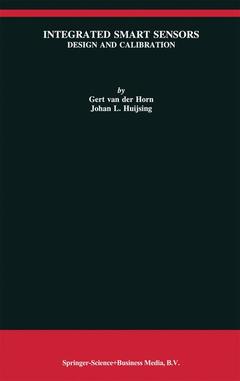Integrated Smart Sensors, Softcover reprint of hardcover 1st ed. 1998 Design and Calibration The Springer International Series in Engineering and Computer Science Series, Vol. 419
Langue : Anglais
Auteurs : Horn Gert van der, Huijsing Johan

1 1. 1 Introduction The (signal processing and storage) capacity ofthe human brain enables us to become powerful autonomous beings, but only if our brains operate in conjunction with (at least some of) our senses and muscles. Using these organs, we can interact with our environment, learn to adapt, and improve important aspects of our life. Similarly, the signal processing capabilities of modern electronics (computers) could be combined with electronic sensors and actuators to enable interaction with, and adaptation to, the (non-electrical) environment. This willlead to smarter and more powerful automated tools and machines. To facilitate and stimulate such a development, easy-to-use low-cost sensors are needed. The combination of electronic interface functions and a sensor in an integrated smart sensor, that provides a standard, digital, and bus-compatible output, would simplify the connection of sensors to standard electronic signal processors (microcontrollers, computers, etc. ). Currently, the calibration procedure, required for standardization of the sensor output signal level, contributes largely to the production costs of accurate sensors. To enable automation of the calibration procedure, and hence reduce the sensor fabrication costs, a digital calibrationjunction should be included in the smart sensor. INTEGRATED SMART SENSORS: Design and Calibration Introduction 1. 2 Sensors and actuators In industry many processes are electronically controlled. As depicted in Fig.
1 Introduction.- 1.1 Introduction.- 1.2 Sensors and actuators.- 1.3 Integrated smart sensors.- 1.4 Measurement errors and correction.- 1.5 Objective and Organization.- References.- 2 Integrated Smart Sensor Concept.- 2.1 Introduction.- 2.2 Silicon sensors.- 2.3 Analog Interface circuits.- 2.4 Analog-to-Digital conversion.- 2.5 Digital bus or microcontroller interface.- 2.6 Integrating a calibration function in the smart sensor concept.- References.- 3 Calibration and Linearization Techniques.- 3.1 Introduction.- 3.2 Linearization.- 3.3 Progressive polynomial calibration method.- 3.4 Conclusion.- References.- 4 Calibration using Analog Signal Processing.- 4.1 Introduction.- 4.2 Conventional sensor calibration.- 4.3 Analog calibration circuits.- 4.4 Classical pulse-modulated calibration.- 4.5 Analog implementation of a polynomial calibration.- 4.6 Conclusion.- References.- 5 Calibration using Sigma-Delta Analog-to-Digital Conversion.- 5.1 Introduction.- 5.2 Sigma-delta AD-converters.- 5.3 Alteration of the sigma-delta transfer.- 5.4 Implementation of the sigma-delta AD-converter.- 5.5 Smart temperature sensor realizations.- 5.6 Conclusion.- References.- 6 Calibration using Digital Signal Processing.- 6.1 Introduction.- 6.2 Hardware implementation.- 6.3 Software implementation.- 6.4 Conclusion.- References.- 7 Summary and Conclusions.
The calibration procedure that is required for manufacturing accurate sensors is, presently, time-consuming and difficult to automate. Hence, it contributes considerably to the sensor fabrication costs. Integrated Smart Sensors: Design and Calibration explains how to include a digitally programmable calibration feature in an integrated smart sensor. Several related topics are discussed as well, including calibration and linearization techniques. Calibration circuits using analog signal processing, digital signal processing, or a mixed-mode technique based on sigma-delta modulation are presented, as well as the other circuits needed in a smart sensor. The combination of a programmable calibration circuit and a digital bus interface, integrated together with the sensor, enables automation of
Date de parution : 12-2010
Ouvrage de 202 p.
15.5x23.5 cm
Thème d’Integrated Smart Sensors :
© 2024 LAVOISIER S.A.S.



